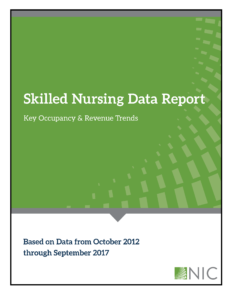NIC Skilled Nursing Data: Downward Pressure on Occupancy Continues
Key Takeaways from the Third Quarter 2017 Report
NIC has just released its third quarter 2017 Skilled Nursing Data Report, which includes key monthly data on skilled nursing metrics from October 2012 through September 2017.
The current report is based on data collected monthly, but reported quarterly, from approximately 20 operators and 1,500 properties. The data represents national, aggregate figures. However, NIC plans to grow the data set, adding more operators and properties to produce state-level reports. NIC welcomes the participation of operators nationwide in this confidential data collection process. Participants will receive a free benchmark report every month for their contribution.
Here are some key takeaways from the report:
- Despite an uptick from July to August, quarterly occupancy reached a new low of 81.6% in the third quarter of 2017, down 29 basis points from the second quarter. For comparison, occupancy increased in the third quarter in 2013 and 2014 and was flat in 2016, so this year’s quarterly decline is most likely not a seasonal phenomenon. The 167-basis point decline in year-over-year occupancy is the second largest decline in the last five years for the third quarter. Downward pressure on occupancy has been steady since May 2015.
- Medicaid patient day mix continues to make up a growing share of occupancy, reaching its highest point in the five-year series at 66.8%. Medicaid mix was up 80 basis points from last quarter and 112 basis points from a year ago. It has increased 422 basis points in the last five years, from 62.6% in the third quarter of 2014.
- Medicare patient day mix declined 58 basis points from the second quarter and 84 basis points from year-earlier levels, coming in at a new low of 12.2% in the third quarter of 2017. The average Medicare patient day mix for the 12-month period ending in September 2017 was 13%, compared to 14% from September 2015 to September 2016, and 15% in the 12-month period from September 2014 to September 2015. While Medicare patient day mix was on the decline, the third quarter also ended with Medicare revenue per patient day reaching its lowest level at $510. Medicare revenue per patient day was down 2%, from $521 in October of last year.
- Managed Medicare revenue per patient day declined from the prior quarter to set a new low within the time series at $431. This represents a total decline of 13.2% from five years ago or a negative 2.8% compounded annual growth rate over the same time period. Quarter-over-quarter, the rate fell 1.8%, which was a significant deterioration from the prior quarterly decline of only 0.2%. The rate fell 2.1% from the year-earlier level of $440 revenue per patient day. Meanwhile, managed Medicare patient day mix declined to 6.2% from its recent five-year high of 6.7% in February of this year. The average managed Medicare patient mix in the latest 12-month period ending September 2017 was 6.3% compared to 5.9% for the previous 12-month period ending September 2016. Managed Medicare patient day mix appears to be generally growing, up from 5.1% at the beginning of the five-year series.
- At 9.1%, private patient day mix matched its lowest point, which occurred in April 2017. The lowest private patient day mixes in the five-year time series have occurred in 10 of the last 12 months. This mix has not exceeded 10% since January 2016. Simultaneously, the private revenue per patient day increased to its highest amount at $266. Each of the last 10 months has witnessed the highest private revenue per patient day amounts in five years. The year-over-year increase reached its highest peak in five years in the third quarter at 2.9%.
NIC released its latest Skilled Nursing Data Report on December 14, 2017. You can download the latest report and future reports here.

